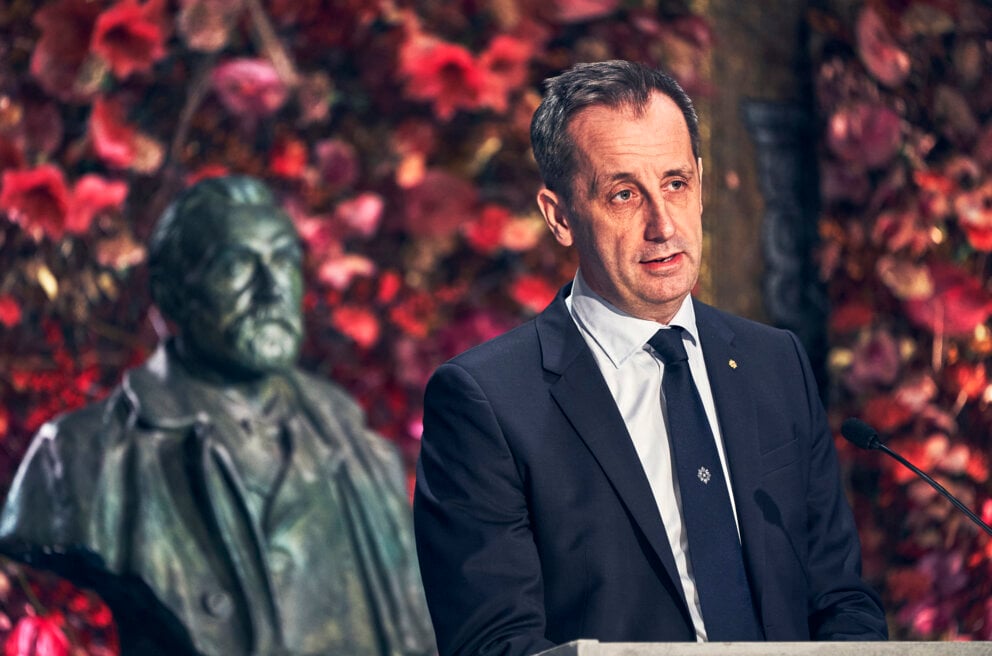Award ceremony speech

Professor Claes Gustafsson delivering the presentation speech for the 2020 Nobel Prize in Chemistry.
© Nobel Prize Outreach. Photo: Dan Lepp
English
Swedish
Presentation Speech by Professor Claes Gustafsson, Member of the Royal Swedish Academy of Sciences; Chairman of the Nobel Committee for Chemistry, 10 December 2020.
Your Majesties, Your Royal Highnesses, Esteemed Nobel Laureates, Ladies and Gentlemen,
The fertilised egg cell contains all the information needed to create a human being, and this information is stored in our genetic material, our DNA. In 1953, James D. Watson and Francis H.C. Crick reported a simple, structural model for DNA, which immediately suggested how the DNA molecule can store genetic information that can be passed on to new generations of cells.
What the DNA structure did not explain, was how the genetic information can be used to give rise to proteins, the main components of human tissues. During the 1950s this was an unanswered scientific question, which occupied a large number of prominent scientists. A breakthrough came on Good Friday, 1960, when a group of international scientists gathered for an informal meeting at King’s College, Cambridge. The group included Sydney Brenner, Francis Crick, and François Jacob, who all later became Nobel Prize laureates. During the meeting, Jacob described the latest results from the work carried out by his colleagues and himself at the Institute Pasteur in Paris. The information provided had an almost seismic effect on Brenner and Crick, who both instantaneously realized the importance of the French findings for their own scientific work. At that very moment they understood that DNA was copied into RNA, which in turn functions as the template for protein synthesis. As so many times before and after, the free exchange of ideas and information between international scientists led to an important breakthrough.
Today we celebrate another scientific breakthrough resulting from an international collaboration, between a French scientist working in the northern part of Sweden and an American scientist based in sunny California. Ever since the early pioneers described the nature of the genetic material, scientists have tried to develop technologies that can manipulate the DNA sequences of cells and organisms. With the discovery of the CRISPR/Cas9 genetic scissors, Emmanuelle Charpentier and Jennifer A. Doudna have provided us with a tool that can be used to change the genetic information of animals, plants and microorganisms with extremely high precision.
As so often in science, the discovery of these genetic scissors was unexpected. During Charpentier’s studies of a harmful bacterium, Streptococcus pyogenes, she discovered a previously unknown molecule, which she called tracrRNA. Her work showed that tracrRNA is part of an ancient bacterial immune system, CRISPR/Cas, that protects the bacterium from invading viruses by cleaving their DNA. How this cleavage was accomplished was demonstrated a year later, when Charpentier and Doudna together succeeded in recreating the bacteria’s genetic scissors in a test tube.
In a series of crucial experiments, the two scientists set out to simplify and reprogram the genetic scissors. In their natural form, the scissors recognise DNA from viruses, but Charpentier and Doudna proved that they could be controlled so that they can cut any DNA molecule at a predetermined site. Where the DNA is cut it is then easy to introduce new genetic information and thereby rewrite the code of life.
Since Charpentier and Doudna discovered the CRISPR/Cas9 genetic scissors in 2012 their use has increased exponentially. This tool has contributed to many important discoveries in basic research. Plant researchers have been able to develop crops with new and desired properties. In medicine, clinical trials of new cancer therapies are underway, and the dream of being able to cure inherited diseases is about to come true.
Emmanuelle Charpentier and Jennifer A. Doudna. Your studies of the CRISPR/Cas9 genetic scissors have taken the molecular life sciences into a new epoch, and are bringing a great benefit to humankind in many ways. That is a truly great achievement. On behalf of the Royal Swedish Academy of Sciences, it is my great privilege to convey to you our warmest congratulations.
Copyright © The Nobel Foundation 2020
Nobel Prizes and laureates
Six prizes were awarded for achievements that have conferred the greatest benefit to humankind. The 12 laureates' work and discoveries range from proteins' structures and machine learning to fighting for a world free of nuclear weapons.
See them all presented here.
